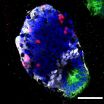What do American babies eat? A lot depends on Mom's socioeconomic background
Dietary patterns start developing as early as 6 and 12 months of age
2014-10-30
(Press-News.org) BUFFALO, N.Y. – You have to be at least 2 years old to be covered by U.S. dietary guidelines. For younger babies, no official U.S. guidance exists other than the general recommendation by national and international organizations that mothers exclusively breastfeed for at least the first six months.
So what do American babies eat?
That's the question that motivated researchers at the University at Buffalo School of Medicine and Biomedical Sciences to study the eating patterns of American infants at 6 months and 12 months old, critical ages for the development of lifelong preferences.
The team found that dietary patterns of the children varied according to the racial, ethnic and educational backgrounds of their mothers.
For example, babies whose diet included more breastfeeding and solid foods that adhere to infant guidelines from international and pediatric organizations were associated with higher household income – generally above $60,000 per year – and mothers with higher educational levels ranging from some college to post-graduate education.
The study, "Sociodemographic differences and infant dietary patterns," was published this month in Pediatrics.
"We found that differences in dietary habits start very early," says Xiaozhong (pronounced Shao-zong) Wen, MBBS, PhD, assistant professor in the UB Department of Pediatrics and lead author on the paper.
Studying the first solid foods that babies eat can provide insight into whether or not they will develop obesity later on, he explains.
"Dietary patterns are harder to change later if you ignore the first year, a critical period for the development of taste preferences and the establishment of eating habits," he says.
Wen conducts research in the UB Department of Pediatrics' Behavioral Medicine division, studying how and why obesity develops in infants and young children.
In the study, babies whose dietary pattern was high in sugar, fat and protein or high in dairy foods and regular cereals were associated with mothers whose highest education level was some or all of high school, who had low household income -- generally under $25,000/year -- and who were non-Hispanic African-Americans.
Both the higher sugar/fat/protein pattern and the higher dairy pattern resulted in faster gain in body mass index scores from ages 6 to 12 months for the babies.
Babies who consumed larger amounts of formula, indicating little or no breastfeeding, were associated with being born through emergency caesarean section and enrollment in the Special Supplemental Nutrition program for Women and Infant Children (WIC). Wen notes that one possible reason for high formula consumption in this group is that WIC provides financial assistance for formula purchases.
Some of the unhealthy "adult foods" consumed by 6- and 12-month-old babies in the study included items inappropriate for infants, such as candy, ice cream, sweet drinks and French fries.
"There is substantial research to suggest that if you consistently offer foods with a particular taste to infants, they will show a preference for these foods later in life," Wen explains. "So if you tend to offer healthy foods, even those with a somewhat bitter taste to infants, such as pureed vegetables, they will develop a liking for them. But if you always offer sweet or fatty foods, infants will develop a stronger preference for them or even an addiction to them.
"This is both an opportunity and a challenge," says Wen. "We have an opportunity to start making dietary changes at the very beginning of life."
The researchers also found that babies whose diets consisted mainly of high fat/sugar/protein foods were associated with slower gain in length-for-age scores from 6 to 12 months.
"We're not sure why this happens," explains Wen, "but it's possible that because some of these foods that are high in sugar, fat or protein are so palatable they end up dominating the baby's diet, replacing more nutritious foods that could be higher in calcium and iron, therefore inhibiting the baby's bone growth."
The UB researchers based their analysis on a subsample covering more than 1,500 infants, nearly evenly split between genders, from the Infant Feeding Practices Study II conducted by the U.S. Food and Drug Administration and the Centers for Disease Control and Prevention from 2005 to 2007. In that study, mothers reported which of 18 different food types their 6- and 12-month old babies ate in a week; those data then were used to develop infant dietary patterns.
INFORMATION:
Co-authors with Wen are Kai Ling Kong, PhD and Chuanbo Xie, MD, PhD, of the Department of Pediatrics; Rina Das Eiden, PhD of UB's Research Institute on Addictions and Neha Navneet Sharma of the Department of Psychology in the UB College of Arts and Sciences.
The project was funded by a seed grant from the UB Department of Pediatrics.
ELSE PRESS RELEASES FROM THIS DATE:
Twenty-first Eastern Pacific tropical depression born on Oct. 30
2014-10-30
NOAA's GOES-West satellite captured an image of the birth of the Eastern Pacific Ocean's twenty-first tropical depression, located far south of Acapulco, Mexico.
NOAA's GOES-West satellite gathered infrared data on newborn Tropical Depression 21E (TD 21E) and that data was made into an image by NASA/NOAA's GOES Project at NASA's Goddard Space Flight Center in Greenbelt, Maryland. At 1200 UTC (9 a.m. EDT), the GOES-West image showed that thunderstorms circled the low-level center and extended northeast of the center indicating that southwesterly wind shear was affecting ...
Reconstruction of a patterned piece of spinal cord in 3-D culture
2014-10-30
Professor Elly Tanaka and her research group at the DFG Research Center for Regenerative Therapies Dresden - Cluster of Excellence at the TU Dresden (CRTD) demonstrated for the first time the in vitro growth of a piece of spinal cord in three dimensions from mouse embryonic stem cells. Correct spatial organization of motor neurons, interneurons and dorsal interneurons along the dorsal/ventral axis was observed.
This study has been published online by the American journal "Stem Cell Reports" on 30.10.2014.
For many years Elly Tanaka and her research group have been studying ...
Harnessing error-prone chips
2014-10-30
As transistors get smaller, they also grow less reliable. Increasing their operating voltage can help, but that means a corresponding increase in power consumption.
With information technology consuming a steadily growing fraction of the world's energy supplies, some researchers and hardware manufacturers are exploring the possibility of simply letting chips botch the occasional computation. In many popular applications — video rendering, for instance — users probably wouldn't notice the difference, and it could significantly improve energy efficiency.
At ...
Female frogs modify offspring development depending on reproduction date
2014-10-30
Global warming is altering the reproduction of plants and animals, notably accelerating the date when reproduction and other life processes occur. A study by the University of Uppsala (Sweden), including the participation of Spanish researcher Germán Orizaola, has discovered that some amphibians are capable of making their offspring grow at a faster rate if they have been born later due to the climate.
Over recent decades many organisms, both plants and animals, have experienced a notable advance in the date when many of their life processes (like reproduction, migration ...
Could daylight savings time be a risk to diabetics?
2014-10-30
Soon, many will turn back the hands of time as part of the twice-annual ritual of daylight savings time. That means remembering to change the alarm clock next to the bed, which will mean an extra hour of sleep before getting up in the morning.
But for some diabetics who use insulin pumps, Saleh Aldasouqi, associate professor of medicine at Michigan State University, suggests that remembering to change the time on this device should be the priority.
"Some diabetes patients who use insulin pumps may forget to change the clock that is found in these devices," said diabetes ...
Is space tourism safe or do civilians risk health effects?
2014-10-30
Rochelle, NY, October 30, 2014—Several companies are developing spacecraft designed to take ordinary citizens, not astronauts, on short trips into space. "Space tourism" and short periods of weightlessness appear to be safe for most individuals according to a series of articles on space biomedicine published in New Space, a peer-reviewed journal from Mary Ann Liebert, Inc., publishers. The articles are available free on the New Space website until November 30, 2014.
James Vanderploeg, MD, MPH and colleagues, University of Texas Medical Branch, Galveston, coauthored ...
NASA sees Cyclone Nilofar looking more like a comet than a tropical cyclone
2014-10-30
Tropical Cyclone Nilofar was closing in on the border between Pakistan and northwestern India on Oct. 30 when NASA's Terra satellite passed overhead from space. Wind shear continued to affect the storm making it appear more like a comet with a tail, than a tropical cyclone.
The MODIS or Moderate Resolution Imaging Spectroradiometer instrument that flies aboard NASA's Terra satellite captured a visible image of Nilofar on Oct. 30 at 06:35 UTC (2:35 a.m. EDT). Nilofar was still being affected by southwesterly wind shear, which was blowing the clouds and showers to the northeast. ...
CHEST lung cancer experts present policy statement to CMS Committee on Coverage
2014-10-30
VIDEO:
Dr. Gerard Silvestri gives background on lung cancer screening recommendations.
Click here for more information.
October 30, 2014, Glenview, Illinois -- As the Centers for Medicare & Medicaid Services (CMS) Committee on Coverage studies the decision to cover lung cancer screening for eligible individuals, today's Online First section of the journal CHEST published Components for High Quality Lung Cancer Screening: American College of Chest Physicians and American Thoracic ...
Clinical practice guidelines address multimodality treatment for esophageal cancer
2014-10-30
Chicago, October 30, 2014 – The Society of Thoracic Surgeons (STS) has released new clinical practice guidelines for treating cancer of the esophagus and gastroesophageal junction (area where the esophagus meets the stomach).
The guidelines, published in the November 2014 issue of The Annals of Thoracic Surgery, include nine evidence-based recommendations that address issues related to multimodality care, including neoadjuvant therapy (chemotherapy and radiation therapy given prior to surgery). The goal of this therapy is to reduce the extent of cancer before an ...
Molecular tumor markers could reveal new therapeutic targets for lung cancer treatment
2014-10-30
Chicago, October 30, 2014—Analysis of 607 small cell lung cancer (SCLC) lung tumors and neuroendocrine tumors (NET) identified common molecular markers among both groups that could reveal new therapeutic targets for patients with similar types of lung cancer, according to research presented today at the 2014 Chicago Multidisciplinary Symposium in Thoracic Oncology. The Symposium is sponsored by the American Society of Clinical Oncology (ASCO), the American Society for Radiation Oncology (ASTRO), the International Association for the Study of Lung Cancer (IASLC) and ...
LAST 30 PRESS RELEASES:
Making lighter work of calculating fluid and heat flow
Normalizing blood sugar can halve heart attack risk
Lowering blood sugar cuts heart attack risk in people with prediabetes
Study links genetic variants to risk of blinding eye disease in premature infants
Non-opioid ‘pain sponge’ therapy halts cartilage degeneration and relieves chronic pain
AI can pick up cultural values by mimicking how kids learn
China’s ecological redlines offer fast track to 30 x 30 global conservation goal
Invisible indoor threats: emerging household contaminants and their growing risks to human health
Adding antibody treatment to chemo boosts outcomes for children with rare cancer
Germline pathogenic variants among women without a history of breast cancer
Tanning beds triple melanoma risk, potentially causing broad DNA damage
Unique bond identified as key to viral infection speed
Indoor tanning makes youthful skin much older on a genetic level
Mouse model sheds new light on the causes and potential solutions to human GI problems linked to muscular dystrophy
The Journal of Nuclear Medicine ahead-of-print tip sheet: December 12, 2025
Smarter tools for peering into the microscopic world
Applications open for funding to conduct research in the Kinsey Institute archives
Global measure underestimates the severity of food insecurity
Child survivors of critical illness are missing out on timely follow up care
Risk-based vs annual breast cancer screening / the WISDOM randomized clinical trial
University of Toronto launches Electric Vehicle Innovation Ontario to accelerate advanced EV technologies and build Canada’s innovation advantage
Early relapse predicts poor outcomes in aggressive blood cancer
American College of Lifestyle Medicine applauds two CMS models aligned with lifestyle medicine practice and reimbursement
Clinical trial finds cannabis use not a barrier to quitting nicotine vaping
Supplemental nutrition assistance program policies and food insecurity
Switching immune cells to “night mode” could limit damage after a heart attack, study suggests
URI-based Global RIghts Project report spotlights continued troubling trends in worldwide inhumane treatment
Neutrophils are less aggressive at night, explaining why nighttime heart attacks cause less damage than daytime events
Menopausal hormone therapy may not pose breast cancer risk for women with BRCA mutations
Mobile health tool may improve quality of life for adolescent and young adult breast cancer survivors
[Press-News.org] What do American babies eat? A lot depends on Mom's socioeconomic backgroundDietary patterns start developing as early as 6 and 12 months of age







